Spend any amount of time in a barn and you will see horses being trained or exercised by moving in a circular fashion around their trainer (either in a round pen, on and off the lunge line, or on the line in a more open area). That is a horse being “lunged.” And while it may look simple enough, it is a skill that like many others, needs to be taught to a horse.
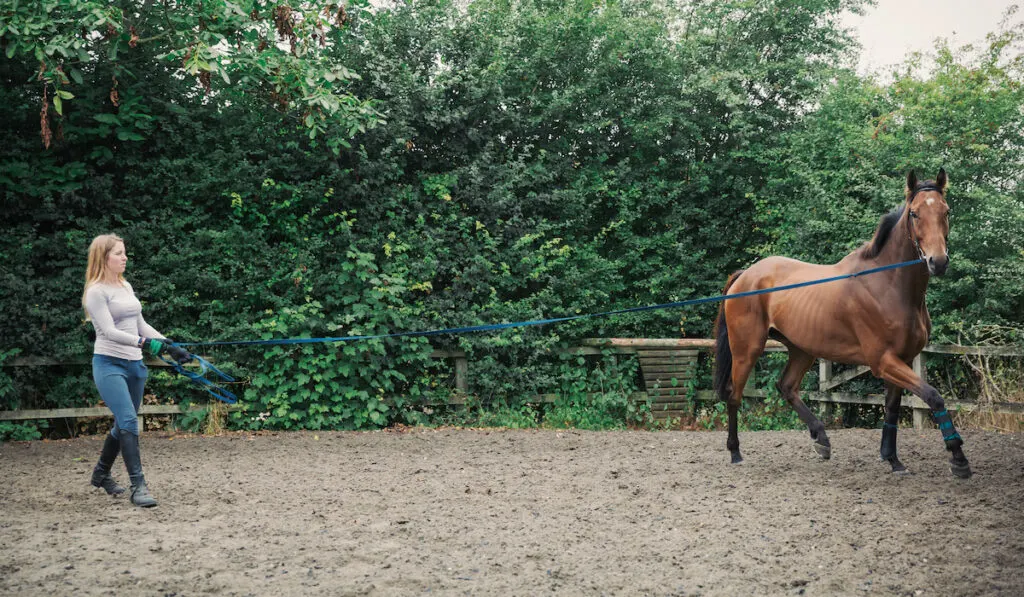
Teaching a horse to lunge isn’t complicated, but following proper technique and training will set both you and your horse up for success. The first time a horse attempts this behavior they won’t know what to do so you must break it down for them into small steps.
Table of Contents
WHAT IS LUNGING?
In the most basic sense, lunging is the act of a horse moving in a controlled circle around a trainer. Either connected to a lunge line or free lunging in a round pen, a lunging horse stays moving in a circle at a pace and direction determined by the trainer ‘s command, be it verbal, via body language, or both.
WHY IS LUNGING IMPORTANT?
Lunging before a ride does a lot for your horse, physically and mentally. (source) It allows them to burn off extra energy and “get the bucks out”, as well as help a horse loosen up, increase flexibility and help improve general fitness.
Especially if they have been sitting in the field or had a few days off, lunging is a good way to ease them into focusing on their work before you hop on their back!
Lunging can also be an excellent way to check a horse’s gait for soundness. On the lunge, you can pick up on signs of lameness. It’s also a good way to build up a young horse’s strength and fitness before carrying the weight of a rider.
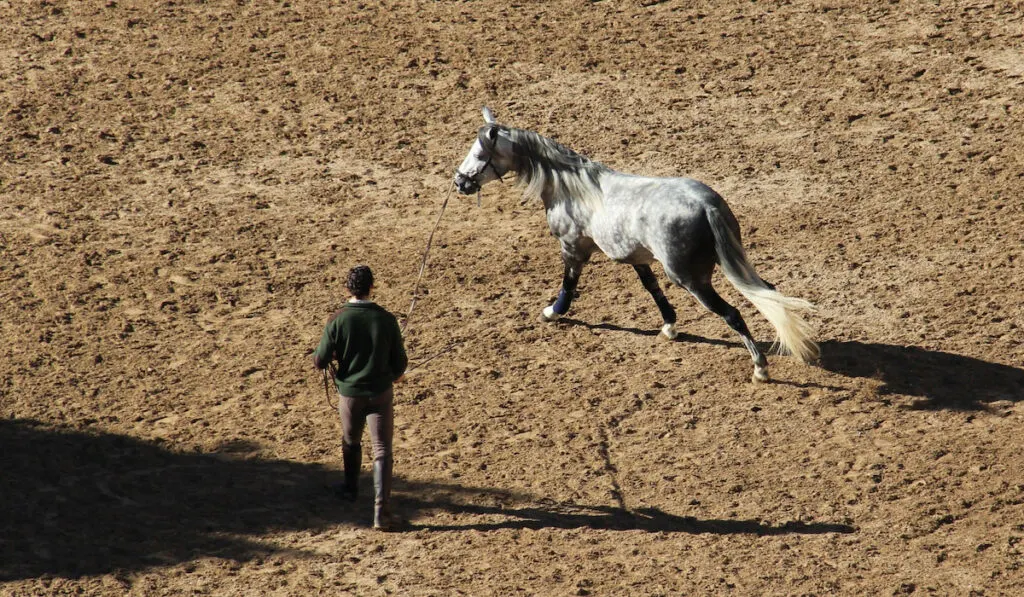
Lunging is an important part of a young horse’s training. A trainer may lunge a young horse with a rider in the saddle. This is a great way to develop the horse’s skills for riding, as you can begin teaching commands in a safe and controlled manner.
Beginning Training – Preparation & Equipment
Prior to actually lunging, you need to make sure you are properly prepared with the right equipment.
Choosing the Right Lunge Line
You will need a lunge line, which should be long enough for your horse to move freely but not so long that he becomes hard to control. (source)
Around 25 to 30 feet long is ideal – if a line is too short, it will make the size of the circle traveled by your horse too small, unnecessarily stressing their joints and tendons.
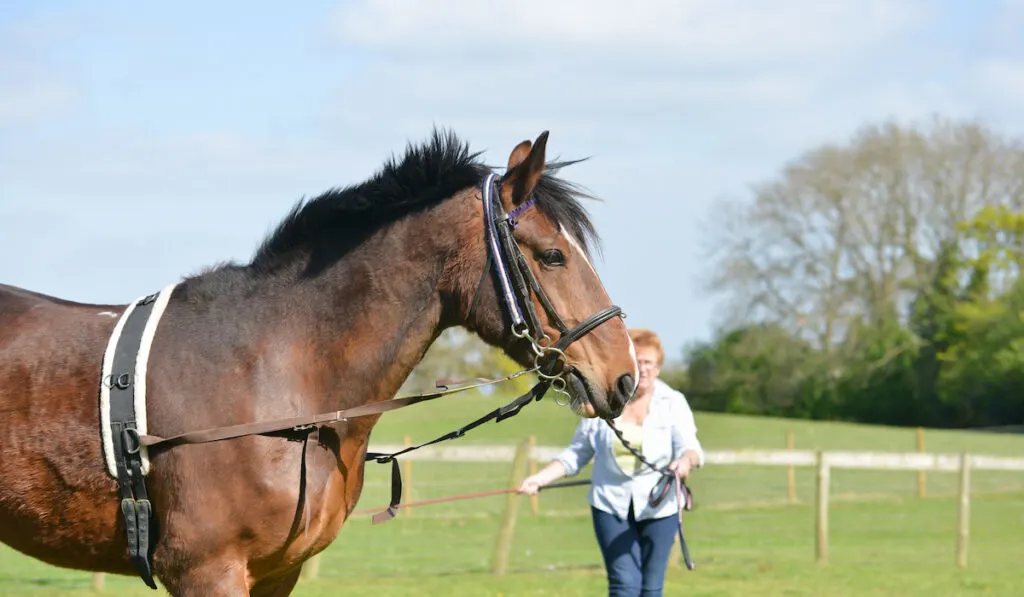
The line should be made of lightweight material. Cotton or flat nylon webbing is better than traditional rope, as it is lighter to hold and handle.
Cotton in particular is less likely to slip from your grip or twist on itself. You can also knot your line at one-foot intervals closer to the end you hold to give yourself measured stops and grips.
Lunge lines should also have a swivel snap for safety. Some lunge lines even come with a chain at the end that can be looped through the nose of a horse’s halter, but this requires a lot of skill to use safely.
Lunge Whip
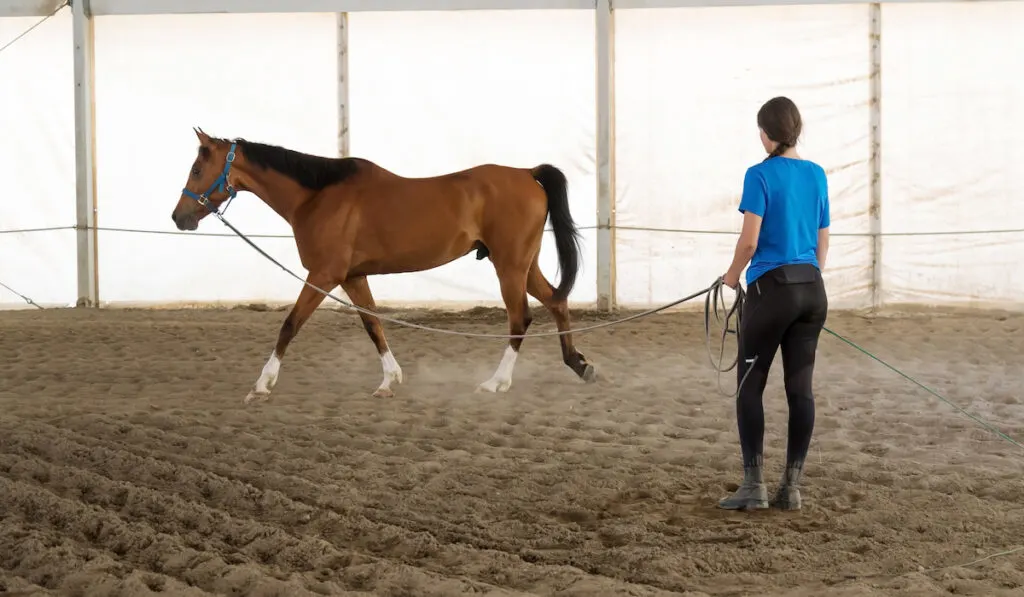
You should also have a lunge whip. Note that this is never to strike the horse, but rather to keep the horse out on the circle and encourage him to move forward.
The tail of the whip can be flicked behind the horse to drive him forward in the circle. It is often also used to changes in speed.
Leg Protection
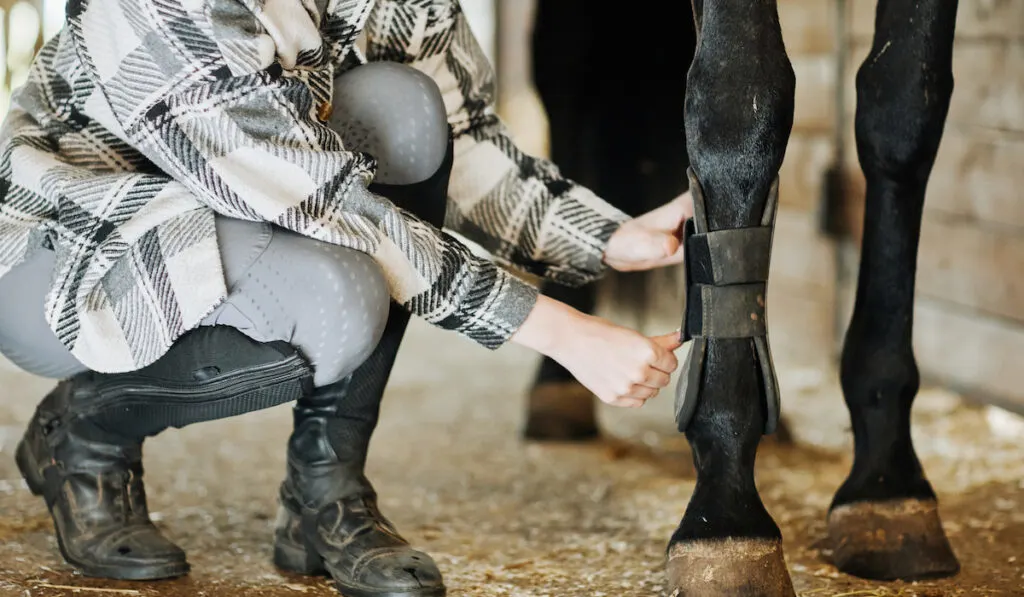
It is also a good idea to protect your horse’s legs with wraps or exercise boots. When your horse is first learning how to lunge, he is more likely to crossfire and injure his legs.
Bell boots are another good precaution and will help prevent the horse from injuring himself if he were to overreach.
Halter or Caveson
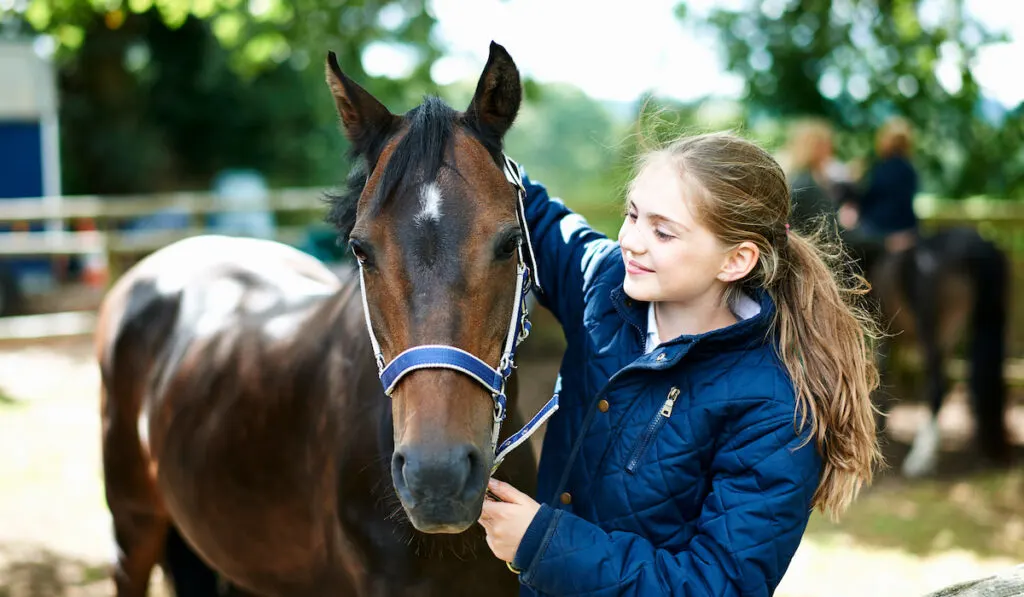
Your horse should have a sturdy halter, or a specially designed lunging halter called a “lunge cavesson”, to connect to the lunge line.
Trainer Gear
Having the right gear for yourself is important too. Make sure you are wearing sturdy, closed toe shoes, such as your riding boots, so your feet are protected and you have plenty of traction. Gloves are essential as they can prevent burns from the line if your horse gets too headstrong.
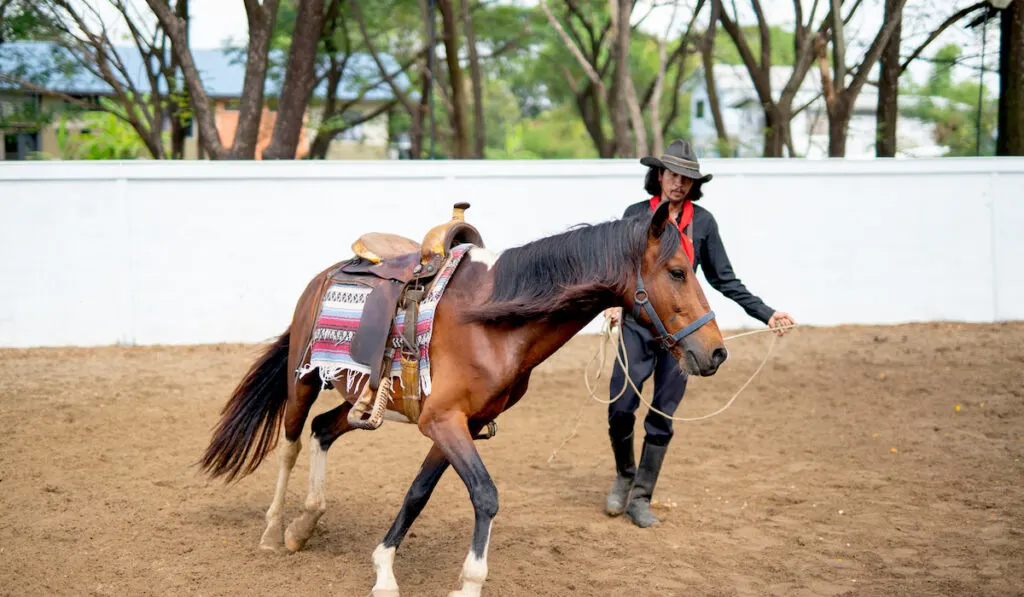
A helmet is never a bad idea, either, since you are working in an enclosed area with a horse. Lastly, your most important tool is your voice – it is what you will use to give your horse cues.
Location
When it comes time to begin lunging, it’s all about location, location, location. You will want a quiet area free from distractions. A round pen is a perfect option, but you can lunge without one. If you don’t have access to a round pen, you will still want a fenced-in area, just in case your horse tries to bolt or gets loose.
Wherever you lunge. there should be enough room for your horse to comfortably work in a circle of approximately 60-70 feet in diameter. The ground should be clear of holes and debris so your horse will not hurt themselves.
Once you’re ready, it’s time to start lunging!
ONCE IN THE RING
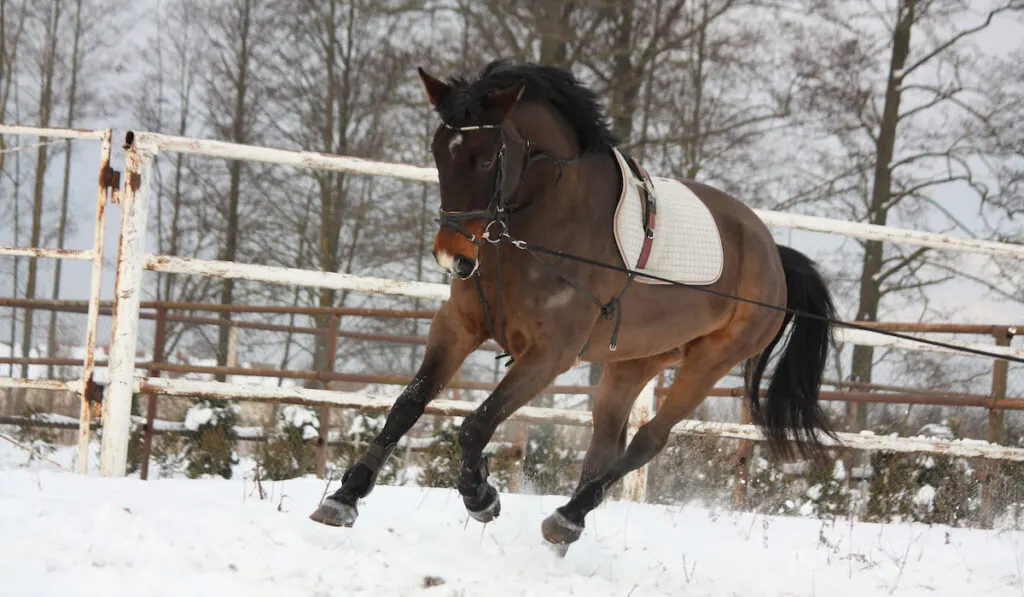
Begin by leading your horse calmly into the ring or pen and lead him along will be the path of the circle. You should walk at their shoulder and not to the rear, so you don’t encourage them to move out before you are ready.
Prepare yourself for the direction you want your horse to go. If you will be working your horse to the left, hold the line in your left (and if you are using a lunge whip, hold that in your right). Reverse this if you will begin by working your horse to the right.
It’s often easiest to begin by lunging your horse in a counterclockwise direction, as horses are used to humans standing at their left side.
Stand facing your horse with the lunge line held at your side, gathered in loops in your left hand and with your arm bent at the elbow. Your stance should be relaxed.
It is important to ensure the lunge line never becomes wrapped around your body or trails on the ground, as you could get tangled in it and badly injured.
Ask your horse to “walk” with that command and an additional clucking cue if needed.
You should keep your commands consistent and align your tone with what you want the horse to do. Use a sharp, lively tone to ask the horse to move faster, and a calmer, slower tone to ask the horse to slow down.
You can extend your arm with the lead rope out, too, to guide the horse forward and away from you. Always ensure your body remains aligned with your horse’s shoulder.
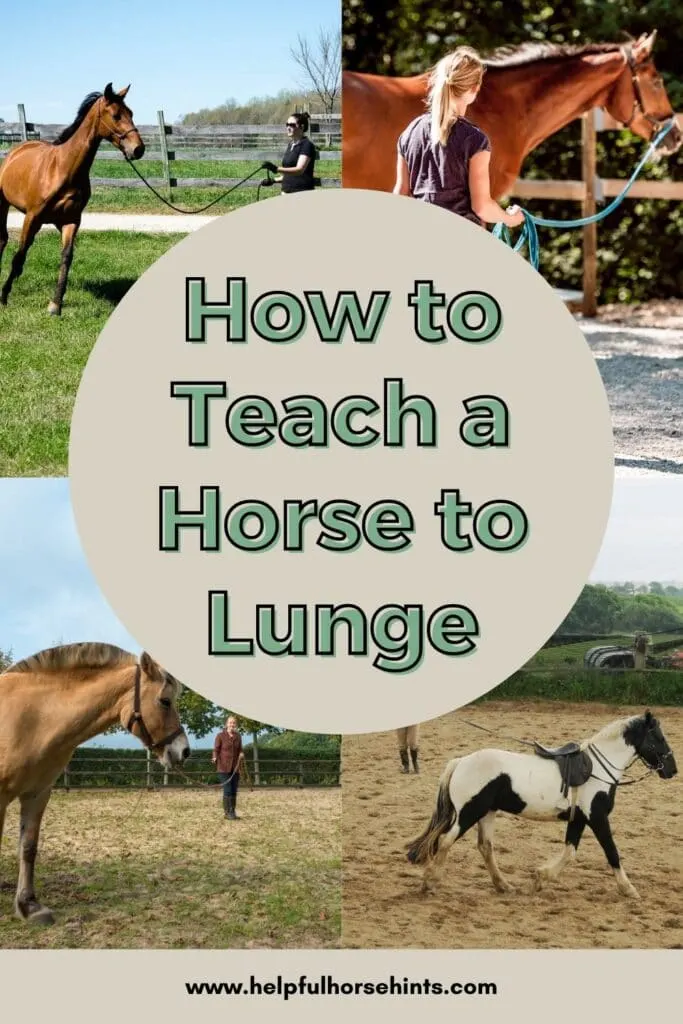
As your horse starts walking, move slightly back and away towards their rear to encourage them to keep walking.
As they move further out, release more of your lunge line until it is fully extended, and your horse is traveling in a complete circle.
As they move around the circle, rotate your body to stay in line with the horse. Make sure you keep the lunge line up off the ground and not dragging.
There should be enough slack, though, to allow your horse to keep moving and so you aren’t tugging on their head. If your horse tries to stop or slow down, cluck at them to keep going, and don’t let them stop or drift into the center of the circle.
Once your horse is walking around the circle well, you can use your lunge line as a directional tool and your body language for forward motivation. You should be facing your horse and aligned with its barrel, keeping your body slightly behind their shoulder to keep them moving.
CHANGING UP LUNGING
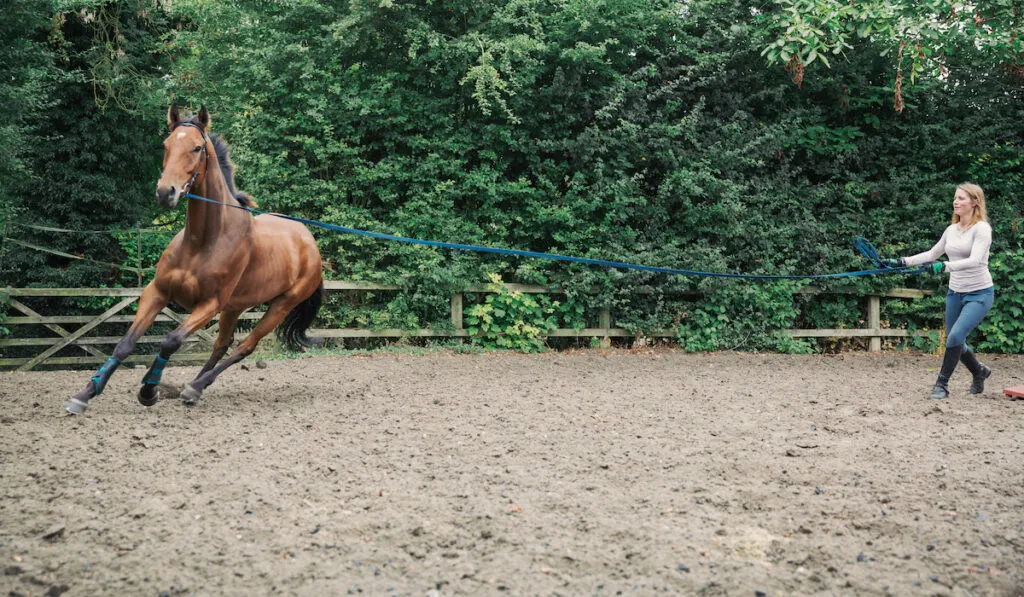
After you’ve mastered the walk in both directions, you can increase the speed to different gaits. Voice commands, clucks, and even whip cracks can be used to signal for your horse to transition to a trot or a canter.
Typically, to go from a walk to a trot, you will ask your horse to “teee-rot” and show the horse the whip (again, never hit your horse with the whip). Also don’t continuously crack the whip, as this will desensitize your horse to its meaning, and they’ll start ignoring cues.
Practice bringing your horse back to a walk by saying “waaaalk” in a slow and low tone and lowering the whip.
If your horse is reluctant to slow down, you can use the line to gradually make the circle smaller. However, never let the circle get so small the horse could kick you or want to turn in to face you.
Once you have mastered going from walk to trot and trot to walk, you can introduce the canter. Ask for the canter by raising the whip again, clucking, and saying “canter.”
Next, you can start using your lunging to teach your horse to jump by lunging them over a pole on the ground. Using varying heights of cavalletti set around the circle, you can lunge your horse on the circle and over the small jumps. This gets them used to picking up their feet and planning for jumps in their path.
This is an excellent way to teach your horse the basics of jumping while still safely on the ground.
Once you and your horse have mastered the basics of lunging, you can explore even more new tools and techniques. For example, you can use “side reins” which helps them learn balance and to stay on the bit.
HALTING YOUR HORSE
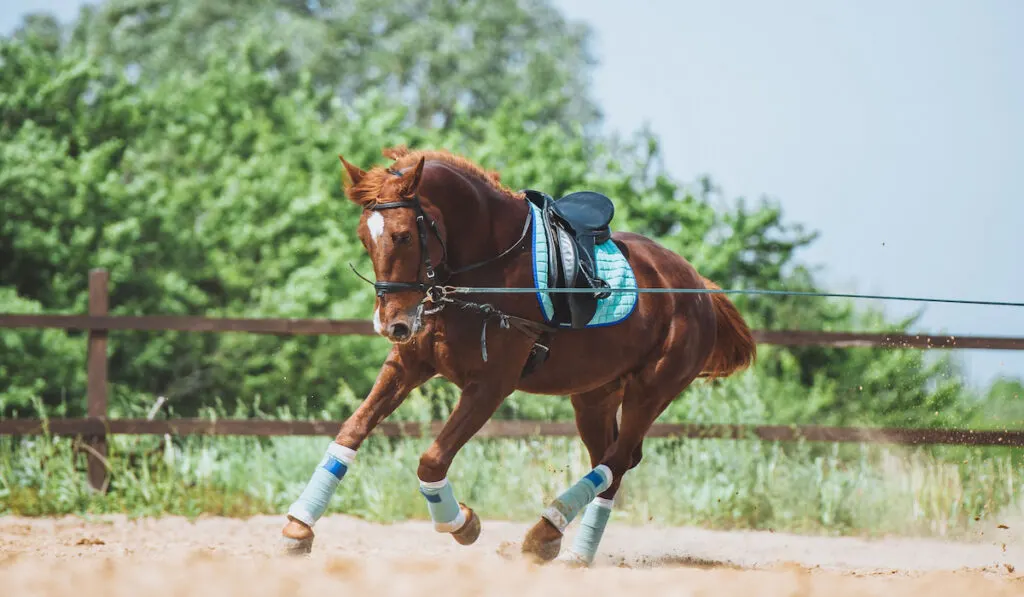
To end your lunge lesson, or when you are ready to change direction, you can ask the horse to halt. Slow your horse to a walk, and then add you halt command (generally like “haaaaalt”) while lowering your arms and the whip.
If your horse is reluctant to halt, you can gently tug at the lunge line. You should never pull or heave on the line, since this is potentially harmful to the horse and also teaches them to turn in to face you or to pull away.
When your horse stops, walk towards them, gathering up the lunge line again in loops. Never pull your horse to you. You should also encourage your horse to stay put once they are stopped and wait for you to walk to them.
POTENTIAL PROBLEMS AND BEHAVIOR CORRECTIVES
Avoiding stress and injury should always be your number one priority, so be sure to lunge your horse for an equal amount of time in both directions. In total, you should never be lunging for more than forty minutes.
Remember that the faster your horse goes, the bigger the circle should be, as too small a path of travel at too fast a gait can cause injury. Let more line out as you increase lunging speed but do so gradually.
A lot of potential problems can be avoided by simply adhering to a principle of consistency. (source)
Always follow a pattern when lunging. It is helpful to work at the same time of day and in the same, enclosed setting every time. Follow the same routine every time, and keep your voice commands consistently.
Remember that horses have complex minds and can get bored quickly, so don’t simply run them in a mindless circle for forty minutes. You should ensure your horse remains honed in on you and obedient throughout the exercise.
It is important that lunging is never used as punishment, as this will create negative connotations in your horse’s mind and undo your partnership. Done correctly, lunging is an excellent way to exercise and train your horse, and to develop a bond on the ground that lasts when you are in the saddle.
Source:
- https://www.uswhip.com/blog/lunge-horse-first-time/

